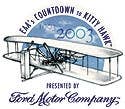
The Wright brothers were a disappointed pair when they arrived back home in Dayton unexpectedly early on August 22, 1901. According to their sister Katherine, they did not talk about flying for days. Their self-confidence was draining, and they felt that two years of time, money and effort had been wasted. Yet of one thing they remained certain-their setbacks on the Outer Banks that summer were not because of their efforts, but because earlier data supplied by pioneers like Lilienthal and John Smeaton (whom they had trusted) was somehow faulty. What they had to do, they realized, was replace uncertainty with hard facts-their facts-in which they could have absolute confidence.
This was where their genius for visualizing mechanical solutions to theoretical problems paid off. First, they mounted an airfoil test rig on a wheel ahead of the handlebars on a bicycle and then rode the bicycle to create a wind. What they found was that Smeaton's original coefficient for air pressure figure in the mode of calculation for flying (which Lilienthal had also used) was far too high. At this point, they decided to recheck all the earlier data, taking nothing as proven until they proved it themselves.
|| |---| | | | The Wrights' homebuilt wind tunnel provided much new data.| To do this, the Wrights built their own wind tunnel-an eight-foot long by 16-inch square box that looked like an ordinary packing crate sitting on two sawhorses. Inside, they constructed two balances from hacksaw blades and bits of wire to accurately measure lift and drag coefficients. With this, over the next two months, they tested more than 200 small wings from three to nine inches long. They measured monoplanes, biplanes and even a tandem plane. Most important, they discovered new lift (weight carrying) specifications that proved all those before them had been wrong. And they found more efficient specs for the wings of a biplane and how to best shape the tips of those wings.
Later, the Wrights would recall that period from mid-November to early December, 1901, as the psychological peak of their career. Daily, they were making new discoveries, breaking new ground, and with that knowledge, their doubts and uncertainties vanished. "Wilbur and I could hardly wait for morning to come," Orville recalled later, "to get at something that interested us. That's happiness."
As Christmas approached, the brothers had good reason for cheer. Now, finally, they had verified facts and figures they could trust. With all this new data now at hand, they had no doubts that they could design, construct-and fly-the most advanced glider in the world when they returned to Kitty Hawk the following year.
This "Kitty Hawk Moment" is brought to you by the EAA, whose Countdown to Kitty Hawk program, presented by Ford Motor Company, includes an exact flying reproduction of the Wright Flyer. It is the centerpiece of the EAA's national tour during 2003, which will conclude with a five-day celebration at Kitty Hawk, North Carolina, where the Wright Flyer will fly again at exactly 10:35 a.m. on December 17, 2003, commemorating 100 years of powered flight.

Sign-up for newsletters & special offers!
Get the latest FLYING stories & special offers delivered directly to your inbox






